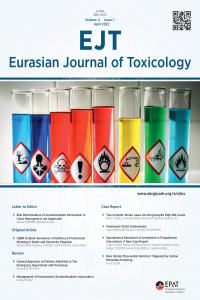Multiple Organ Failure Due to Fungal Intoxication; Case Report
mantar, zehirlenme, multipl organ yetmezliği
Multiple Organ Failure Due to Fungal Intoxication; Case Report
Fungus, Intoxication, Multiple Organ Failure,
___
- Reference 1. Ergüven, M., Çakı, S., & Deveci, M.. Mantar zehirlenmesi: 28 vakanın değerlendirilmesi. Çocuk Sağlığı ve Hastalıkları Dergisi.2004. 47(4), 249-53.
- Reference 2. Sonmez, B. Demographic and Clinical Characteristics of Mushroom Poisonings Presenting to Emergency Department. Journal of Clinical and Analytical Medicine. 2014. 6(100), 469-472.
- Reference 3. Chew, K. S., Mohidin, M. A., Ahmad, M. Z., Kamauzaman, T. H. N. T., & Mohamad, N. Early onset muscarinic manifestations after wild mushroom ingestion. International journal of emergency medicine. 2008. 1(3), 205-208.
- Reference 4. Kintziger, K. W., Mulay, P., Watkins, S., Schauben, J., Weisman, R., Lewis-Younger, C., et all. Wild mushroom exposures in Florida, 2003–2007. Public Health Reports. 2011. 126(6), 844-852.
- Reference 5. Ye, Y., & Liu, Z.. Management of Amanita phalloides poisoning: A literature review and update. Journal of critical care. 2018.Aug;46:17-22.
- Reference 6. Magdalan, J., Piotrowska, A., GomuŁkiewicz, A., Sozański, T., Podhorska-OkoŁów, M., Szeląg, A., et all. Benzylpenicyllin and acetylcysteine protection from α-amanitin-induced apoptosis in human hepatocyte cultures. Experimental and toxicologic pathology. 2011. 63(4), 311-315.
- Reference 7. Wittebole, X., & Hantson, P. Use of the molecular adsorbent recirculating system (MARS™) for the management of acute poisoning with or without liver failure. Clinical Toxicology. 2011. 49(9), 782-793.
- Reference 8. Evenepoel, P., Laleman, W., Wilmer, A., Claes, K., Maes, B., Kuypers, D., et all. Detoxifying capacity and kinetics of Prometheus®–a new extracorporeal system for the treatment of liver failure. Blood purification. 2005. 23(5), 349-358.
- Reference 9. Ferreira, R., Romaozinho, J. M., Amaro, P., Ferreira, M., & Sofia, C.. Assessment of emergency liver transplantation criteria in acute liver failure due to Amanita phalloides. European journal of gastroenterology & hepatology. 2011. 23(12), 1226-1232.
- Yayın Aralığı: Yılda 3 Sayı
- Başlangıç: 2019
- Yayıncı: Acil Tıp Uzmanları Derneği
Cem TERECE, Veysel Osman SOĞUKPINAR, Nazım ÖZDEMİR, Sinem POLAT
A Dystonia Case Due to Metoclopramid Usage
The Effects of Magnesium Levels on Prognosis in Organophosphate Poisoning
İsmail AKTAŞ, Ramazan KÖYLÜ, Öznur KÖYLÜ, Başar CANDER
Multiple Organ Failure Due to Fungal Intoxication; Case Report
İlksen DÖNMEZ, Handan ÇİFTÇİ, Eray ATALAY, Gülşen ÇIĞŞAR
Sultan Tuna AKGÖL GÜR, Ayhan AKÖZ
Sinem DOĞRUYOL, İlker AKBAŞ, Zeynep ÇAKIR
The Evaluation of Blood Glucose and pH Levels of the Patients Who Attempt Suicide With Drug Overdose
İlker AKBAŞ, Sultan Tuna Akgöl Gür, Abdullah Osman Koçak
Acil Servise Parasetamol İntoksikasyonu Nedeniyle Başvuran Hastaların Değerlendirilmesi
Meral TANDOĞAN, Emine EMEKTAR, Seda DAĞAR, Yücel YÜZBAŞIOĞLU, Rabia Handan KARAATLI, Yunsur Çevik
